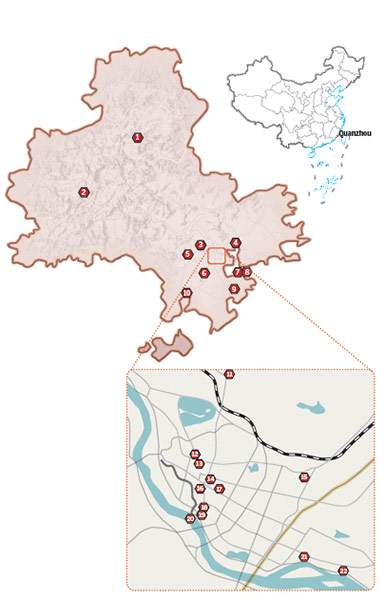

22 sites included in "Quanzhou: Emporium of the World in Song-Yuan China", a new entry to the UNESCO World Heritage List.
1. Dehua Kilns: It's an outstanding example of the porcelain kiln sites that dotted the outskirts of Quanzhou during the Song-Yuan period (960-1368).
2. Xiacaopu Iron Production Site: One of the dedicated iron plants set up by the Song Dynasty government.
3. Jiuri Mountain Wind-Praying Inscriptions: Carved in the cliff, these inscriptions record the ritual ceremonies held by state commissioners, local officials and members of the imperial clan responsible for the management of overseas trade in the Song Dynasty. Their purpose was to pray for favorable winds to aid voyages.
4. Luoyang Bridge: This was a transportation hub connecting Quanzhou northward to Fuzhou and the nation's vast heartland and represented the pinnacle of Chinese bridge-building technology in the Song-Yuan period.
5. Cizao Kilns: They are outstanding examples of the porcelain kiln sites during the Song-Yuan period.
6. Statue of Mani in Cao'an Temple: It is a temple of Manichaeism, originating from ancient Persia.
7. Shihu Dock: It's part of the water-land transshipment center connecting to the old city in the suburbs.
8. Liusheng Pagoda: The site where merchant ships would shift course from the main shipping route to inner ports of Quanzhou.
9. Wanshou Pagoda: A landmark for merchant ships arriving at the port of Quanzhou.
10. Anping Bridge: A vital transport link between Quanzhou and the vast southern coastal region.
11. Statue of Lao Tze: China's largest surviving Taoist stone-carved statue.
12. Kaiyuan Temple: The largest Buddhist temple in Quanzhou with top-ranked official status during the Song-Yuan period.
13. Site of Southern Clan Office: This was an administrative agency established for Song Dynasty kinsmen who relocated to Quanzhou in 1130.
14. Confucius Temple and School: A place for Confucians to offer sacrifice and the city's highest institute of education.
15. Islamic Tombs: They are believed to be the final resting places of two Muslim saints who came to Quanzhou in the seventh century.
16. Site of Maritime Trade Office: This was an administrative agency established by the governments of the Song and Yuan dynasties in Quanzhou to manage maritime trade affairs.
17. Qingjing Mosque: The first Islamic mosque built in Quanzhou.
18. Tianhou Temple: This site is dedicated to the worship of Mazu, the sea goddess.
19. Site of Deji Gate: The remains of the southern gate to the old city of Quanzhou.
20. Site of Shunji Bridge: The main access route to ancient Quanzhou's commercial district.
21. Zhenwu Temple: The Taoist temple is dedicated to the worship of Emperor Zhenwu and the landmark within the port was the venue chosen by Quanzhou officials to offer sacrifices to the sea.
22. Estuary Docks: A water-land transshipment center connecting to the old city in the suburbs.